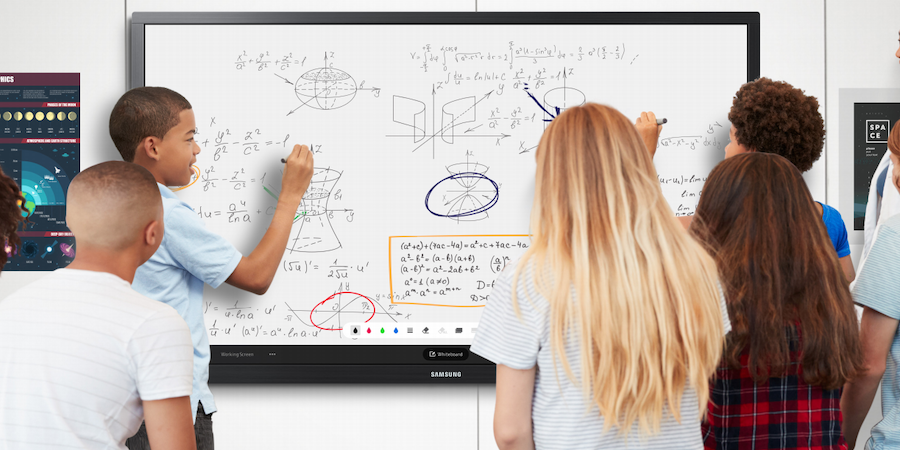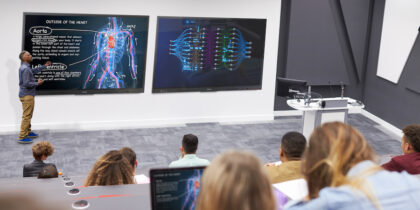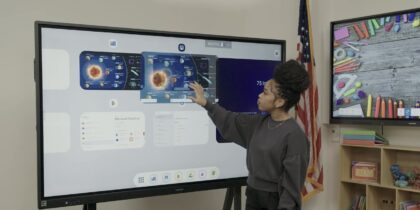In the picture above, we see a teacher. We know this because the woman is standing at the front of what seems to be a classroom with a writing implement, at a board. It is a depiction we are all familiar and comfortable with, no matter how archaic it now is.
My exaggerated use of the word archaic was meant to make a point. Simply that the classroom has changed so much in the past few years, that this is no longer what our classrooms should look like. The COVID-19 pandemic can be credited with accelerating the shift of the classroom into a more technical and interactive space. The new classroom is filled with screens, keys, cables and chargers, and significant reliance on some kind of network access.
This shift toward the integration and adoption of technology in the classroom has undoubtedly impacted the pedagogical approach and practice of all educators rebounding from remote learning.
We are still modeling for our students and building scaffolds, but our challenge has been to create lessons that are even more engaging. COVID-19 alone is not the only catalyst for this shift. Our students are increasingly more tech-savvy and tech-reliant, and some have not known a world without apps and a touchscreen. Pen and paper are far from retired, but they must now step aside for or work in conjunction with newer, more robust classroom tools that allow students to connect and collaborate more quickly and efficiently.
A new picture of the classroom
So what should our classrooms look like? What do your classrooms look like? How have they changed? We have known for a long time that the word engagement is educational sriracha. You can just about put it on everything, and you should! Because engagement is the difference between staring at the clock and waiting for it all to end and a classroom that is buzzing with paperless and wireless information.
Make learning fun with interactive technology
Learn why interactive learning matters and how prioritizing it engages students and improves outcomes. Download Now
Now a high-tech classroom alone does not equate to better pedagogical practice, and the use of a computer does not enliven your classroom discussion unless you create new ways for students to engage with the material and one another. The new classroom is to be student-led, but in order for them to lead, we need to supply them with the tools to do so. In this high technological, post-pandemic age, the best tools are a marriage between hardware and software. The best engagement tools allow us to interact with content from one source, on all devices.
These tools should bring the classroom together to collaborate and build on ideas. They should allow students to pick up where they left off and to work from anywhere — without sacrificing the quality of engagement.
Fantastic tech and where to find … them?
I know! During the course of remote learning, we teachers spent a lot of time being introduced to and learning about new educational software to keep our classrooms going. (We were actually often given about a week or two to learn and then build stellar lessons.)
During that time, we fell more in love with Google Classroom and Zoom because they saved our lives. We got acquainted with Pear Deck and Nearpod (a personal favorite) because they allowed us to add engagement in a remote setting. I would be remiss not to mention Flipgrid (now Flip) and tools like Jamboard, which allowed teachers and students to get creative with learning. But what else? You’ve been brave enough to learn and conquer all of those. What else is there?
Well, if the tools you’re already using in your classrooms make learning fun and exciting, by all means, please continue to engage your students with them. For those of you with an appetite for more and a hunger to find new tools for your student leaders, I have compiled a short list of seven resources that you may want to try at your leisure.
7 tools for the student-led classroom
Below you will find the names of these tools and a brief description of how you might plan to use them in your student-led classroom. I have also created a “Wakelet” that will list all of these options with a corresponding video and a link to the website so you can create an account. The seven tools are either completely free or have a free version you can start using today. Five of the tools are collaboration tools, while the other two are fun tools you and your students may find meaningful and engaging!
- Incredibox: Incredibox is a music-mixing software that allows you to piece sounds and rhythms together to compose your own beats. Not only does it offer a fun standalone activity, but it allows students to get creative with any presentation. Imagine having students explore the tone and mood of a text by scoring a scene from a chapter using Incredibox. Imagine adding background music to a class presentation that fits the context. Now that’s incredible!
- Drawalong AR: Drawalong AR is an augmented reality (AR) tool from the Google Experiments Lab that allows the use of virtual tracing paper! Although this is not a collaboration tool, it is a great way to aid students with handwriting and drawing for artistic application.
- Google Keep: Google Keep is a note-taking software that allows you to take and share notes that can be accessed from any device. Google Keep naturally plays well with other Google apps, allowing you to set reminders and schedule events. This is a great way for students to collaborate while keeping track of group projects and assignments, as well as delegating tasks.
- Diigo: Diigo is an annotation tool that takes annotation to the next level. Diigo will allow students to annotate articles directly from their browser. Students can highlight and add sticky notes directly to a webpage using the extension. All annotations are stored within the student’s Diigo account where they can access the link and see each individual annotation in the order it was taken. Students can save and organize these annotations into specific folders, tag similar or relevant content, and add their findings to groups within Diigo. It is a great tool for small group projects and research.
- Wakelet: Wakelet is an amazing tool that you can use to organize the list of links you have stored in a Google Doc somewhere. Wakelet allows you to take a list of links and compile them in a space that gives you clear insight into what they actually are. From there, you can share the compilation using one link, keeping everything nice and neat and visually appealing. It is a great way for students to share a presentation or to store a library of information that may be helpful to others.
- Padlet: Padlet reminds me of the collaboration board in Nearpod that I love so much. Padlet is a virtual board where you can invite collaboration of all kinds. The customizing features allow you to organize contributions in whatever ways serve you best. Links and QR codes make it easy to see all ideas in an eye-catching way. Students will undoubtedly have many uses for this tool as they can customize multiple boards for a variety of projects.
- Slido: Slido makes it easy to ask questions and conduct live polling during any presentation, virtual or in person. Setting up a topic and inviting attendees to participate is a quick and easy process. Students and teachers can interact with their audience in real time or pre-construct quizzes, polls and questions to be asked during a live session.
Pace yourself — and keep an open mind
When it comes to trying out new software to complement your pedagogy, it’s important to pace yourself. There is no need to feel like you have to be familiar with every tool out there. Rather than pressuring yourself to be an expert in all things tech, it is more of a beneficial practice to remain open-minded.
If something is already working for your classroom, that’s great. But ask yourself some of these key questions from time to time. Am I getting the most out of my class by using what I already know? Are teachers in my discipline finding better results or experiencing greater engagement with a different tool? When was the last time I researched something else? These questions will ensure that you set and maintain an environment conducive to the student-led classroom.
Our Samsung Education team is dedicated to helping your efforts as a curator for your classroom. Not only do we offer in-person professional development, but we are always looking out for ways in which we can provide additional support throughout the school year. Check back each month as we offer more tools, ideas and resources to help teachers on their journey to offer the best experience for their students.








